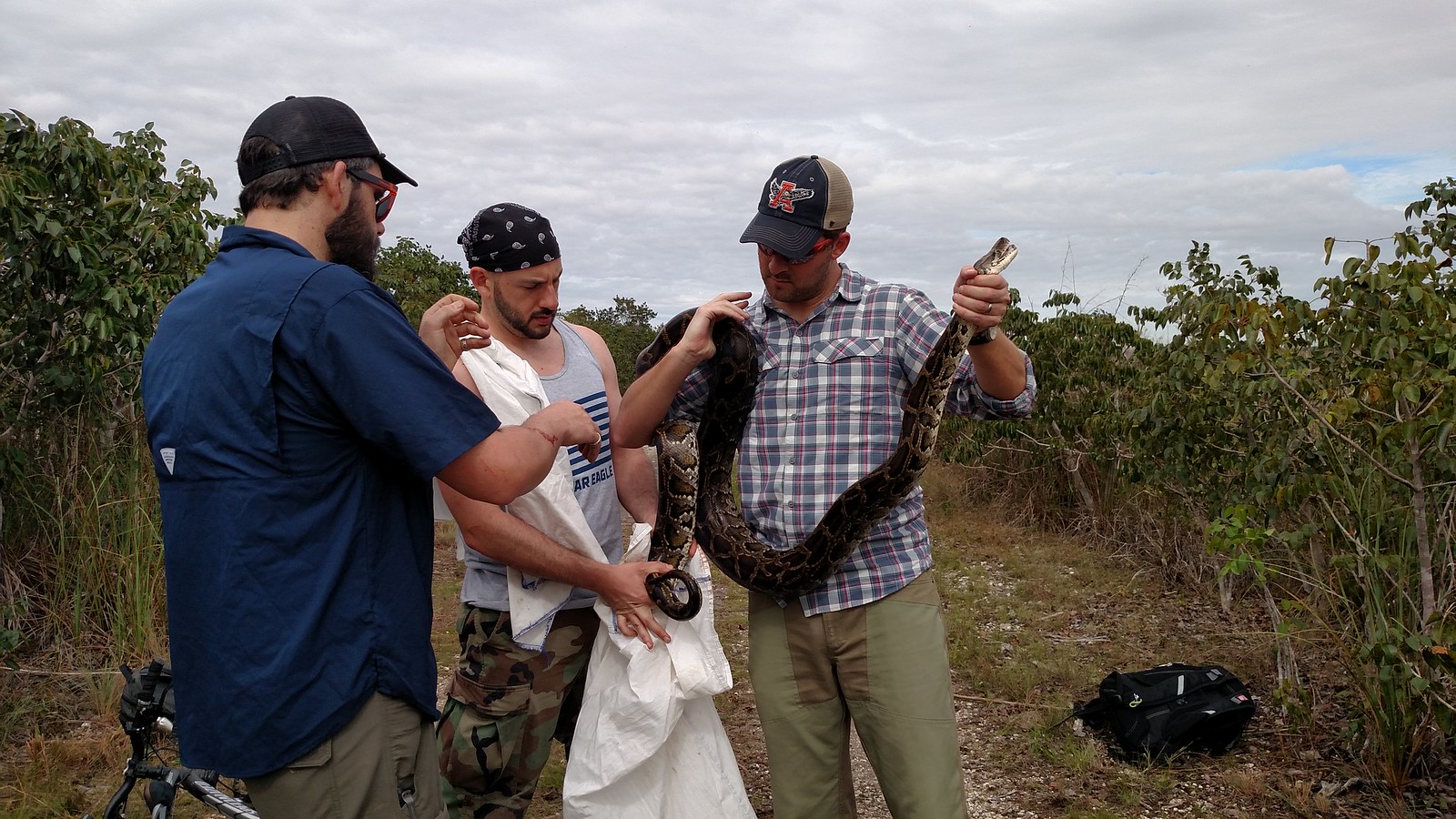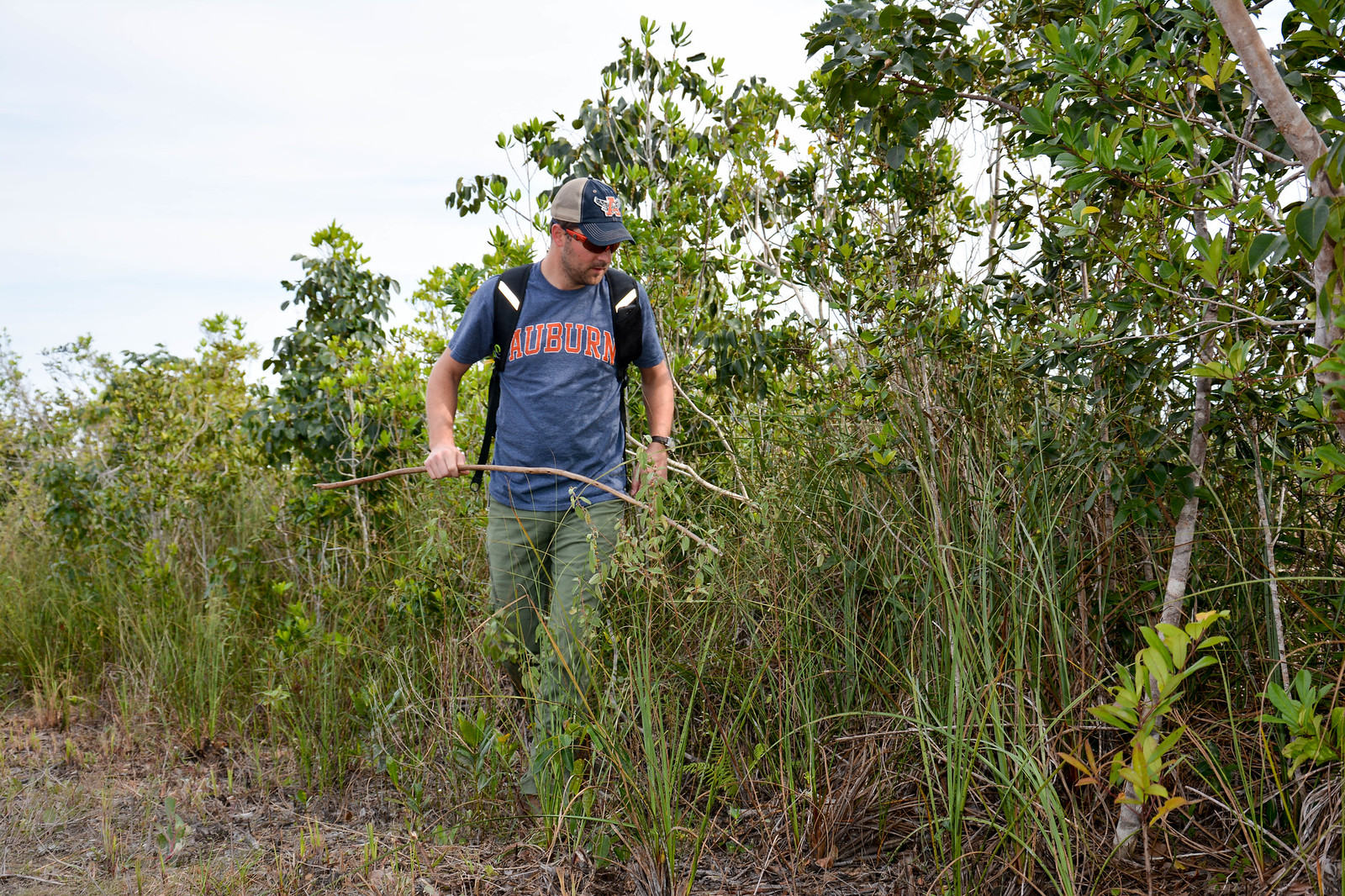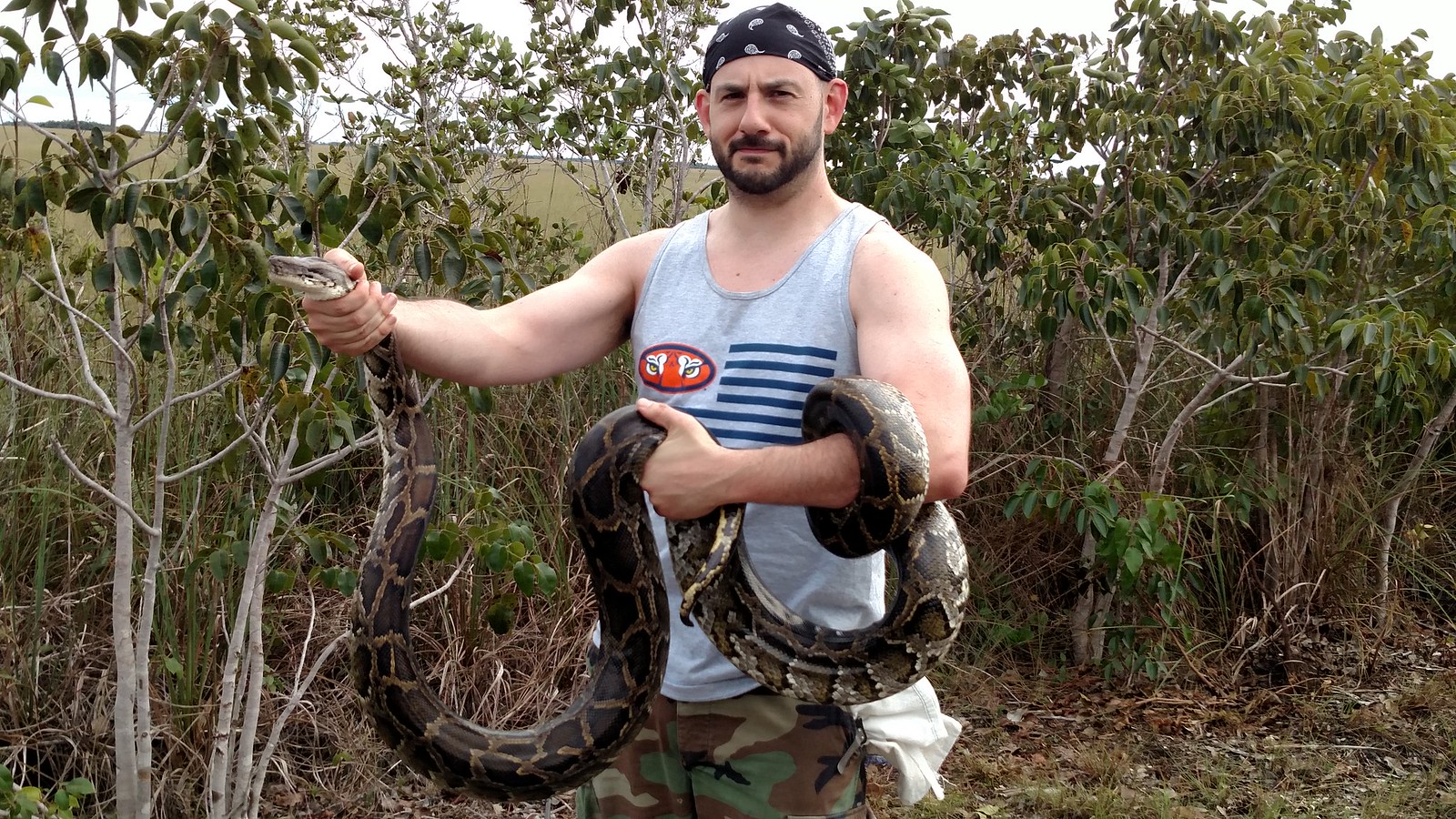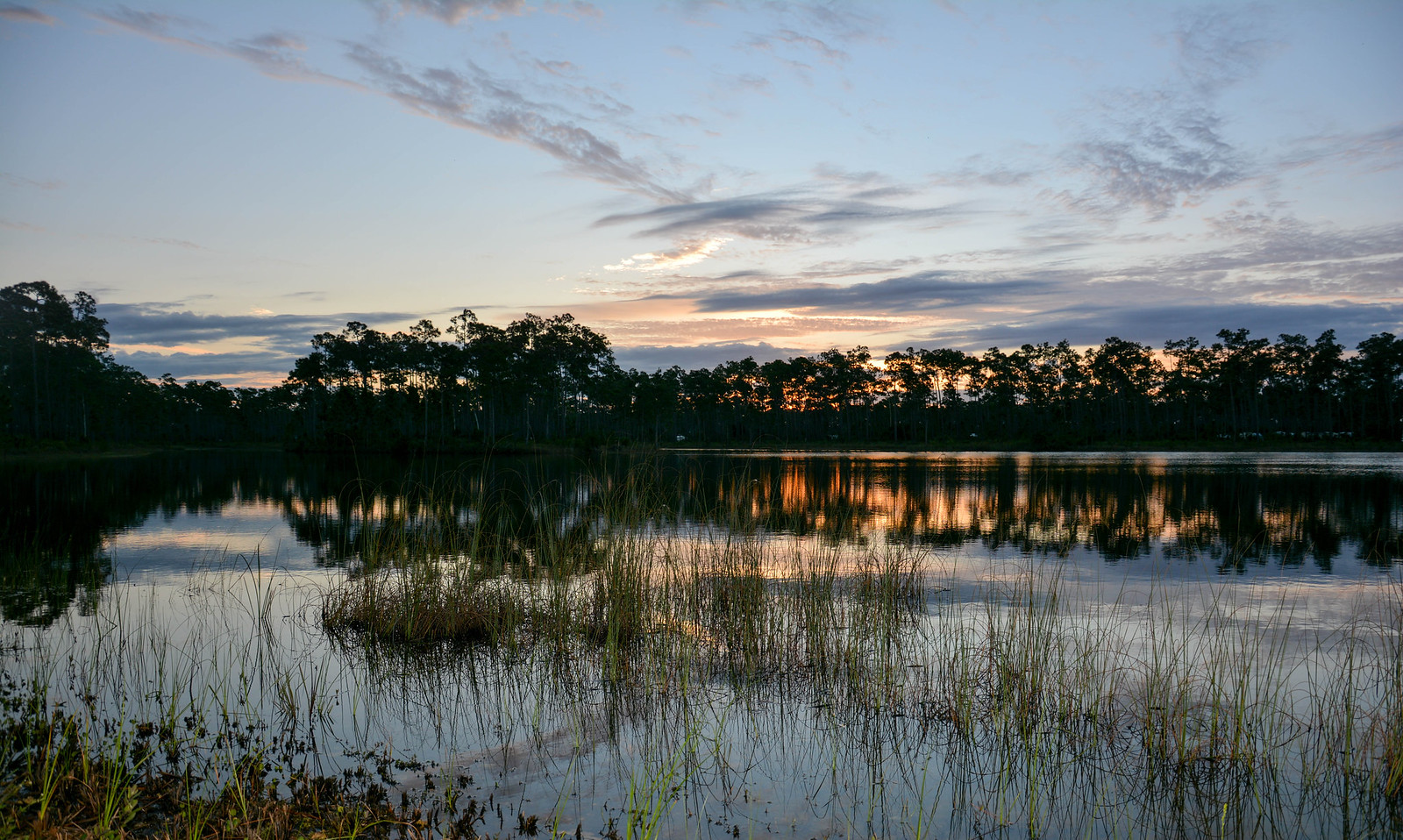COSAM News Articles 2016 February Auburn biologist and alumni seek invasive Burmese Pythons in Everglades competition
Auburn biologist and alumni seek invasive Burmese Pythons in Everglades competition
A team led by Auburn University biologist David Steen is participating in the 2016 Python Challenge in south Florida. The event, sponsored by the Florida Fish and Wildlife Conservation Commission and the Fish and Wildlife Foundation of Florida, is geared toward eradicating the Burmese Python from the region and raising awareness of the serious consequences posed to the environment by the invasive predators.
Competitors are tasked with finding and capturing as many Burmese Pythons as possible between January 16 and February 14. Top awards go to the team with the most captured pythons and the team that captures the longest python. The search area consists of 1.5 million acres of swamp and sawgrass, terrain that provides easy camouflage for the snakes. Although it is estimated that as many as 100,000 Burmese Pythons inhabit the Everglades, in 2013, the only other time the Python Challenge took place, approximately 1,600 people participated and only 68 pythons were captured.
The reason for such a low number of captured snakes is their superior camouflaging ability. Steen, who received a doctorate in biological sciences from Auburn in 2011 and is now an assistant research professor in the university’s College of Sciences and Mathematics, said his team has utilized a variety of hunting techniques to increase the chance of locating and capturing pythons.
The team has driven a vehicle, which allowed them to quickly scan the landscape hoping to stumble upon a snake crossing the road or basking in the sun; they have walked approximately 35 miles, slowly searching every nook and cranny along a canal; and they have used a bicycle in an attempt to cover more ground while others remain on foot. The bicycle technique has proven the most successful thus far.
“We were in the Southern Glades Wildlife and Environmental Area, which is a hotspot for python spotting, particularly along a large canal running through the property,” said Steen. “Sean Sterrett, who is another member of our team, took a bike to cover more ground. Sean was biking and saw movement on the side of the canal, and when he got out he found himself tackling a large python. We had spent days talking to each other about what we would do if we see one. Will I be brave enough to do it? He proved himself brave enough and took it on. It was a large python, about 10-feet long. He was all by himself with one bag at the time. So he started calling everybody. There’s pretty bad reception out there so his calls just went to our voicemail. Later, when we realized he had left all these messages — ‘Hey I've got a big one here and need a bigger bag. Give me a hand’—we all started running toward where we thought he was.”
Sterrett is a herpetologist and postdoctoral researcher at the United States Geological Survey in Massachusetts.
“It was an out-of-body, surreal, adrenalin-rush type experience. I am a herpetologist and have caught some really big snakes, like Diamondback Rattlesnakes, but nothing this big,” said Sterrett. “When I saw the snake, I stepped back and assessed the situation and realized I needed to grab it before it got away. I reached in and didn’t know where I was grabbing it – it turns out I was about 6 inches behind the head, and that was just enough space for it to turn and grab me. I wrestled with it a little bit to get it under control. It took a little while because it was a pretty feisty snake.”
Sean Graham, assistant professor of biology at Sul Ross State University who received a doctorate in biological sciences from Auburn University in 2011, is also on the Python Challenge team. Graham and Steen worked toward their doctorates at the same time in the lab of Craig Guyer, a professor of biological sciences at Auburn who is a widely recognized expert herpetologist.
“It's really neat to have an opportunity to take the knowledge we learned at Auburn and apply it out in the field, getting dirty and catching big snakes,” said Steen.
The fourth team member is Stephen Neslage, a senior coordinating producer at The Weather Channel who received a bachelor’s degree in radio-television-film from Auburn in 2005. Although not a herpetologist, Neslage is an outdoor enthusiast who met Steen when he was a guest on The Weather Channel show, “Weather Geeks.”
“People believed that when Hurricane Andrew came through, exotic pets got flooded out of people’s homes, and that’s how pythons got into the Everglades. Dave helped us prove that is probably not true. Dave busted the Hurricane Andrew python myth for us,” said Neslage. “When he said he was going to do this Python Challenge, I thought, ‘It sounds like a heck of an adventure.’ The thought of going into a harsh landscape, hunting an apex predator and taking it alive … that’s a rush. I had read about the Python Challenge in 2013 and thought it sounded incredible, but I didn’t know what to expect. I had never been to the Everglades, never tried to capture a python. The brush is really thick, so if you are looking for colors, you won’t see it. To find a python, you have to look for something shiny and round. They have elite level camouflage.”
In addition to learning to spot pythons, team preparations were made months in advance by looking at maps, discussing strategies, and talking to other experts about plotting routes through the Everglades.
“We knew pythons are hard to find. In the back of my mind I knew there was a strong possibility that we would end up going home without seeing one, let alone catching one,” said Steen. “It was a big relief to check that box off. Now we can focus on finding more instead of just proving ourselves.”
Locating pythons isn’t the only challenge the team faces. The Everglades also provide a relentless sun and deceptively rough terrain.
“We have logged many miles of walking, wading through mud and dirt, trying to avoid the sun. After 20 miles, we all really started to feel it,” said Steen.
Sunscreen, hats, close-toed shoes, heavy duty pants, long-sleeved shirts and headlamps are essential to the hunt.
“The whole operation is pretty low tech. Basically we need blood, sweat, tears and pillowcases,” said Steen. “But this is something we like to do for fun, this is something we do in our work, and we have lots of knowledge and experience that should help us during the competition.”
A conservation biologist, the most important tool Steen brings to the competition is his high-level of expertise derived from years of extensive herpetological research. Among his latest research endeavors is developing a project with Auburn’s Canine Performances Sciences program to evaluate whether detection dogs can be used to find Indigo Snakes in south Florida. In the past he also helped out on an Auburn School of Forestry and Wildlife Sciences project investigating how effective people and dogs were at finding Burmese Pythons in the same region, an experience that taught him a lot about locating pythons in the wild, as well as the unique set of challenges that come with hunting the enormous predators.
“I have been bitten by almost every type of nonvenomous snake in the Southeastern U.S. so I’m not particularly intimidated by Burmese Pythons. That said, capturing a python can be harrowing,” said Steen. “These are big and potentially dangerous animals. They have a serious bite, and it’s something you don’t want to take too lightly. Capturing a python needs to be done very carefully. You grab the snake from behind its head. If it is large, it is ideal to have another person there to control the coils. Once the snake is in hand, you can put it in a large pillow case.”
In addition to hunting pythons, Steen and his team will take note of other wildlife present in the Everglades.
“The Burmese Python is an invasive species, which means they are exotic and damaging to the native environment. They are from Asia and are likely here because of the pet trade; owners have either purposefully or accidentally allowed their pythons to escape. Unfortunately, they have established a population in south Florida and are suspected to have played a role in the steep declines of native mammals, their prey,” said Steen. “The longest native snake in North America is the Eastern Indigo, which can reach a size of 8.5 feet long. Burmese Pythons, by contrast, can reach a maximum length of approximately 26 feet, dwarfing the native Eastern Indigo. There are concerns that the Burmese Python is competing with native species like the Eastern Indigo for food and space.”
According to the Python Challenge website, in addition to threatening native wildlife and preying upon wading birds, small mammals and other reptiles, the Burmese Python is spreading nonnative disease and parasites, thus damaging important recreational and commercial fisheries and agricultural crops. The environmental and economic threat posed by pythons is expected to continue as experts believe it might be impossible to eradicate the invasive snake from south Florida, despite efforts to reduce the population in the region.
“South Florida is an amazing place, particularly Everglades National Park and the surrounding area. The native biodiversity is really special. You have the American Crocodile, alligators, a whole wide array of wildlife. The flip side of that is there is also a large number of invasive species like the Burmese Pythons, Mediterranean Geckos, Brown Anoles, the Cuban Tree Frog. These are all really adding up together to hammer home why invasive species are such an issue here in south Florida,” said Steen.
“The unofficial reason I decided to participate in the competition is because it’s fun. I am friends with my teammates, we don’t see one another very often, and it has been fun hanging out and camping. Plus, for me, looking for snakes is a hobby, and it’s not often that I get to do it in a competition. Officially, public outreach and science communication are important to me, and this competition presents an opportunity to reach a lot of people in a fun manner and talk about the very real threat invasive species pose to our ecosystems.”
Steen is a faculty member in the Auburn University Department of Biological Sciences and a researcher with the Auburn University Museum of Natural History’s Alabama Natural Heritage Program. In addition to work with Burmese Pythons, he is a leader on the Eastern Indigo Snake reintroduction project. The goal of the project is to reestablish the nonvenomous Eastern Indigo Snake in its native habitat in south Alabama. He has also conducted research on the Argentine Black and White Tegu, a large, non-native, predatory lizard reaching 4 feet in length and more than 10 pounds that is also invading the south Florida ecosystem.
For more information on Steen, follow his blog at www.livingalongsidewildlife.com, his Twitter account at Twitter.com/AlongsideWild, or visit his website at www.auburn.edu/cosam/steen.
For more information on the Python Challenge, visit the website at pythonchallenge.org.
Latest Headlines
-
02/12/2025
-
02/11/2025
-
02/10/2025
-
01/30/2025
-
12/03/2024




